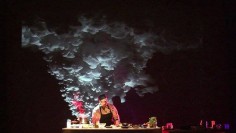TOPOLOGICAL MEDIA LAB MOVEMENT EXPERIMENTS
tabletap
source: betatopologicalmedialabnet
The Topological Media Lab (TML) was established in 2001 as a trans-disciplinary atelier-laboratory for collaborative research creation. In 2005, TML moved to Concordia University and the Hexagram research network in Montréal, Canada.Its projects serve as case studies in the construction of fresh modes of cultural knowledge and the critical studies of media arts and techno-science, bringing together practices of speculative inquiry, scientific investigation and artistic research-creation practices. The TML’s technical research areas include: realtime video, sound synthesis, embedded sensors, gesture tracking, physical computing, media choreography, and active textiles. Its application areas lie in movement arts, speculative architecture, and experimental philosophy.
.
.
.
.
.
.
.
source: betatopologicalmedialabnet
The Topological Media Lab approaches media arts and technologies research as a creative endeavour that cuts across disciplines and fields of experience. The TML describes its atelier research as studying processes of “subjectivation, agency and materiality from phenomenological, social and computational perspectives.” It approaches this by suspending assumptions about what we think are ego’s, humans, machines, objects, and subjects, and think instead of transformations on things, and see how they emerge in play and process. This is informed by a continuous, rather than tokenized object or grammar-based, approach to material change, hence the “topological” aspect. Topology is a field of mathematics concerned with the non-metric (non-numerical) properties of space and the continuous, dynamic relationships through which space is constituted.
TML researchers investigate how people build, inhabit and use sensate or active matter. Philosophically, TML research draws inspiration from the phenomenology of the Merleau-Ponty’s later writings, the questioning of representation and meaning by Wittgenstein, the philosophy of technology of Simondon, and ethico-aesthetic sensibilities of Guattari amongst other sources. The TML is both an atelier and a research laboratory for research in improvisatory gesture and movement from humane but also non-anthropocentric perspectives. Projects conducted in the atelier draw on and inform research in the areas of performance, music, media arts and embodiment theory. The topological experiments also contribute to ongoing research in the computational and natural sciences, seeking to understand the dynamic interplays of social, psychical and material space.
.
.
.
.
.
.
.
source: betatopologicalmedialabnet
A performance choreographed around a chef and sonified objects: fruit, vegetables, meat, knives, pots and pans, cutting board and table.
Cooking*, the most ancient art of transmutation, has become over a quarter of a million years an unremarkable, domestic practice. But in this everyday practice, things perish, transform, nourish other things. Enchanting the fibers, meats, wood and metal with sound and painterly light, we stage a performance made from the moves(gestures) of cooking, scripted from the recipes of cuisine both high and humble…
A performance choreographed around a chef and sonified objects: fruit, vegetables, meat, knives, pots and pans, cutting board and table.
Cooking*, the most ancient art of transmutation, has become over a quarter of a million years an unremarkable, domestic practice. But in this everyday practice, things perish, transform, nourish other things. Enchanting the fibers, meats, wood and metal with sound and painterly light, we stage a performance made from the moves(gestures) of cooking, scripted from the recipes of cuisine both high and humble. Panning features virtuosic chefs who are also movement artists, such as Tony Chong.
Within our responsive scenography system, every cooking process is transformed into an immersive multimedia environment and performance; A multi-sensory experience composed of scent(smell), light, video, sound, movement, and objects. Every process is experienced across many senses at once. The sizzling sound of hot oil, and the mouthwatering aroma of onion and garlic hits the audience within an audio-visual thunderstorm. At the very end, the audience is invited to taste a sample of the dish within the accumulated sonic environment.
The acoustic state evolves via transmutations of sound, light and image in an amalgam of, not abstract data, but substances like wood, fire, water, earth, smoke, food, and movement. Panning allows the performers modulate these transmutations with their fingers and ears and bodies – the transmutation of movement into sound, chemical reaction into sound, and sound into light and image.
Panning is the first part in a series of performances exploring how everyday gestures/events could become charged with symbolic intensity.
Materials:
Self contained responsive kitchen set embedded into our portable table8.1 speaker system, projectors, food


